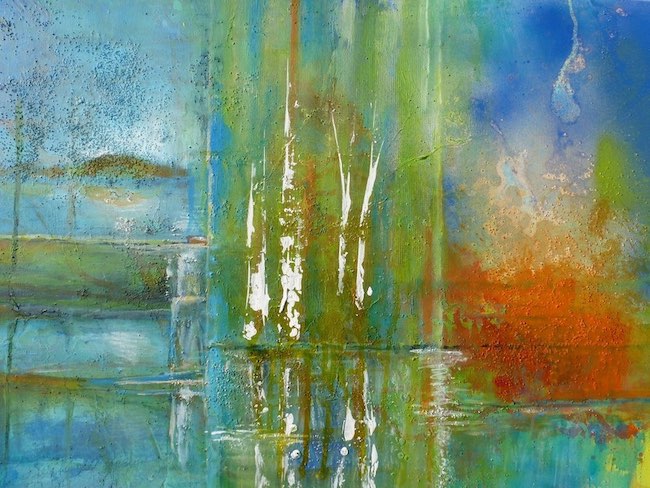La contemplazione della natura, dell’ambiente che circonda l’essere umano e che spesso diviene prezioso scrigno di emozioni, ricordi, evocazioni di un vissuto passato che rimane indelebile nella memoria, esercita da sempre un fascino irresistibile in molti artisti, alcuni dei quali hanno basato sulla sua rappresentazione la loro intera produzione. La modalità con la quale ne hanno parlato si è sempre assecondata all’indole espressiva, all’inclinazione naturale verso un determinato tipo di linguaggio, in alcuni casi più rappresentativo in altri più ermetico, ma sempre frutto della connessione tra ciò che veniva osservato e ciò che veniva percepito. L’artista di cui vi racconterò oggi parte dal visibile per spingersi verso una più o meno parziale dissoluzione dell’immagine in virtù della quale si spinge nelle profondità del proprio sentire.
A partire dagli inizi dell’Ottocento, la predisposizione alla narrazione di panorami privi della presenza umana si fece strada soprattutto in quegli artisti più orientati a lasciare che il loro sguardo si perdesse nella bellezza degli elementi naturali, mettendo in secondo piano tutta l’attenzione al soggetto, inteso come individuo, su cui si era concentrata invece l’attenzione ritrattistica dei movimenti pittorici precedenti. Il Romanticismo Inglese, con William Turner e John Constable, sottolineò con l’uno la forza irresistibile degli eventi atmosferici in virtù dei quali emergeva l’esiguità dell’esser umano, e con l’altro invece il potere evocativo e distensivo del perdersi dentro panorami familiari e legati a ricordi piacevoli, costituendo entrambi un punto di partenza per un approccio all’arte differente, più propenso a mettere in risalto tutto ciò che veniva messo in secondo piano rispetto al protagonismo dell’uomo pur di fatto essendo la presenza di quest’ultimo trascurabile nel contesto più ampio dell’esistenza del mondo. Qualche anno dopo, l’Impressionismo introdusse addirittura la pittura en plein air, dove l’autore di un’opera si poneva in diretto contatto con i paesaggi per dipingere in modo istintivo, senza la presenza di un disegno preparatorio e con l’utilizzo di rapide e brevi pennellate con cui riproduceva le tonalità naturali e la luce che aveva davanti a sé; malgrado l’intento pittorico degli impressionisti fosse orientato a una riproduzione più estetica che emozionale, è innegabile che alcuni paesaggi di Claude Monet non possono non toccare le corde interiori che vibrano di fronte alla lirica poetica delle sue opere. Con l’avvicinarsi del Novecento emerse un nuovo movimento, l’Espressionismo, che raccolse le eredità del Postimpressionismo, dunque un rifiuto dell’estetica e una celebrazione di tutto ciò che era legato al mondo emotivo al punto di distaccarsi dalla realtà osservata per dare la propria personale interpretazione del paesaggio, come nelle incantevoli e agitate tele di Vincent Van Gogh o le intense ambientazioni di Ernst Ludwig Kirchner dove ciò che predominava su tutto era la sensazione percepita. Con l’introduzione dell’Astrattismo, dove l’arte non doveva più essere legata né all’emozione né al visibile, si creò una frattura tra il contatto con la natura dei percorsi precedenti e l’artista che doveva essere l’esecutore di un gesto plastico epurato da qualunque contatto con la realtà; di fatto però questo tipo di approccio allontanò l’autore dalla sua soggettività e dal proprio sentire, entrambi di fatto recuperati con l’Espressionismo Astratto dove qualsiasi sensazione poteva essere manifestata in maniera libera e spontanea, armonizzandosi al sentire del singolo esecutore dell’opera.
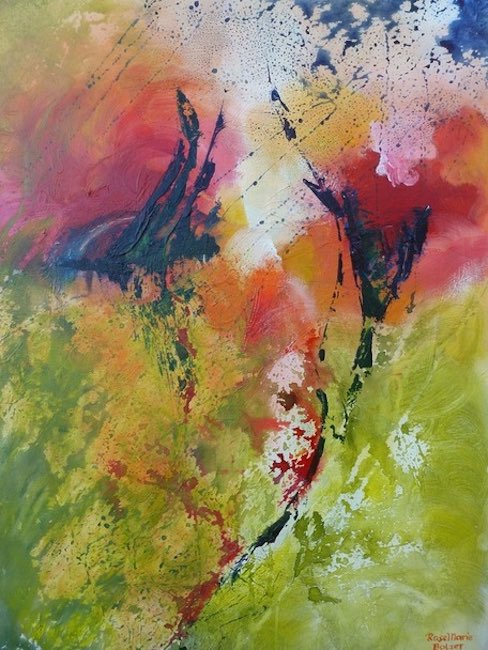
Ed è esattamente su questo stile pittorico che si manifesta la creatività dell’artista austriaca Rose Marie Bolzer, la quale attinge alle emozioni e alla bellezza che riceve osservando i contesti naturali per poi lasciare che quelle stesse sensazioni si concretizzino sulla tela in maniera assolutamente priva di regole, senza la necessità che siano legate alla figurazione ma che possano anche sceglierla qualora il suo istinto lo ritenga necessario. Non solo, all’impulso creativo, dove non può fare a meno di emergere il benessere, il senso di pace, generato davanti agli scorci marini, boschivi, floreali che costituiscono la sua costante fonte di ispirazione, Rose Marie Bolzer aggiunge anche una forte inclinazione alla sperimentazione che la induce a mescolare i colori, essenzialmente vernici acriliche a base d’acqua, con un leggero strato di materia, principalmente la sabbia, la pasta strutturale, che infondono consistenza e maggiore profondità al risultato finale e su cui poi agisce con pennelli, spatola, spugne e anche le mani.

La gamma cromatica è delicata e sfumata in alcuni dipinti mentre più intensa e piena in altri, sulla base della sensazione che l’artista descrive, ma in ogni caso ciò che emerge in modo chiaro e inequivocabile è quell’impronta lirica, quella poesia che si sprigiona ogni qualvolta l’essere umano in generale, e l’artista in particolare, trovano quel contatto con l’elemento naturale troppo spesso dimenticato o messo in secondo piano rispetto all’urgenza del vivere.
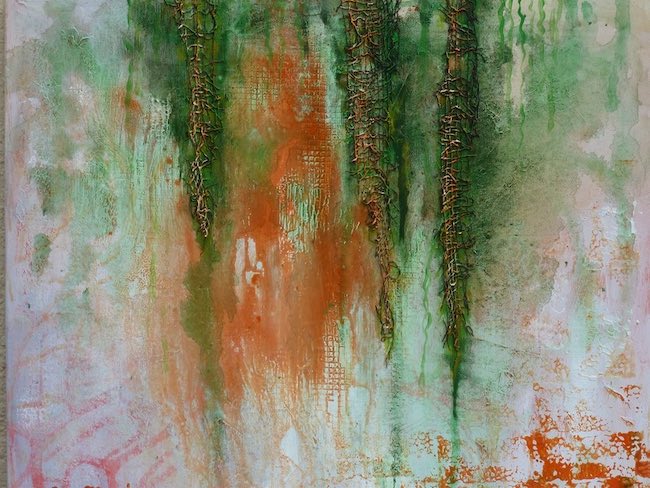
Il suo Espressionismo Astratto dunque non è tormentato, non mostra irruenza, piuttosto si accorda alla poliedricità della natura, a tutto quel ventaglio di emozioni che mutano sulla base del mutare dello stato d’animo ma anche del paesaggio con cui di volta in volta la Bolzer si confronta; così come gli scorci che osserva vengono filtrati e rielaborati dalle sue profondità fino a fuoriuscire trasformati e rielaborati dalla sua sensibilità che la induce ad allontanarsi dal visibile per porsi in contatto con l’invisibile, con tutto ciò che non può essere notato con gli occhi bensì solo percepito con l’anima.
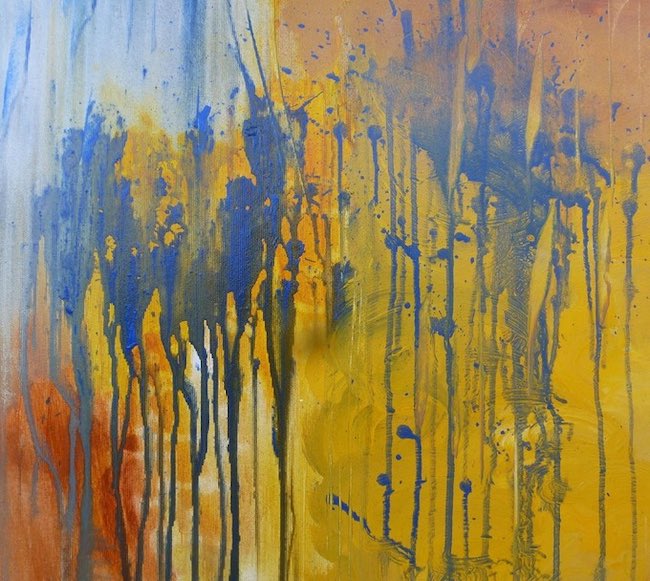
La tela Herbstwald (Bosco autunnale) è intensa, sembra che l’artista si sia posta all’interno del paesaggio che poi racconta, in modo aperto, interattivo, è per questo che le tonalità, pur risultando irreali, sono affini all’autunno, a quel particolare periodo dell’anno in cui la natura sembra voler morire per poi successivamente compiere il percorso di rinascita; il giallo ocra dello sfondo rappresenta dunque il colore delle foglie cadute, ma anche quella sensazione di suggestivo silenzio che avvolge il bosco nel momento in cui sembra addormentarsi per entrare nelle braccia del sonno invernale. Il dripping blu sembra voler rappresentare i tronchi secchi, senza chioma, la cui vitalità scivola via verso il basso.
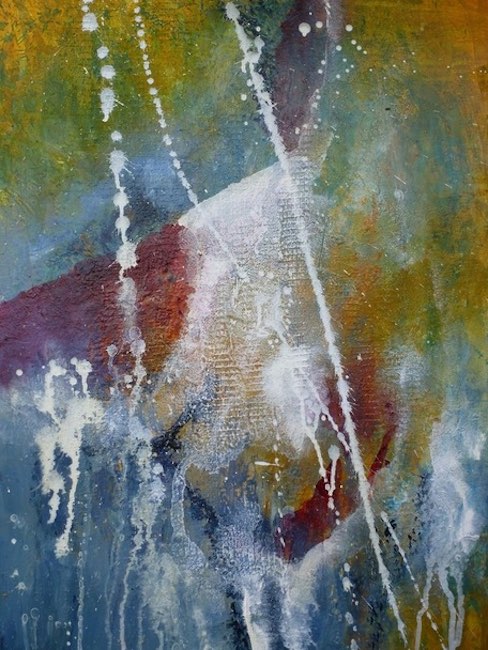
Rose Marie Bolzer invita l’osservatore a riflettere su quanto sia importante prendere esempio dai cicli della natura ogni volta in cui si trova di fronte a difficoltà che non hanno via d’uscita, perché a volte è necessario lasciar andare, o morire, tutto ciò che non è più funzionale al proprio cammino, per poter ricominciare a vivere una nuova esistenza, più affine alle proprie corde. In Rote Felsen (Rocce rosse) l’artista si sofferma nella contemplazione di uno scorcio inusuale, quello di rocce che hanno un colore innaturale eppure evidentemente possibile tanto quanto sono infinite le opzioni con le quali la natura, e la vita, si manifesta; in questa tela è evidente l’introduzione della materia che in qualche modo rimane discreta, mai invasiva, eppure in grado di emergere, dando maggiore spessore all’immagine, perché in questo caso Rose Marie Bolzer desidera mettere l’accento soprattutto sulla consistenza della pietra, protagonista dell’opera, e del contrasto con quella tonalità rossa che la contraddistingue. Quest’opera è decisamente contemplativa, la sensazione dell’artista è quella di ammirazione per la bellezza davanti ai suoi occhi, ed è solo quella che ha sentito il bisogno di immortalare quando si è posta davanti alla tela. Ma spesso le emozioni devono prevalere sull’osservato, su qualcosa che è solo stimolo a un’interiorizzazione perché è solo nel silenzio della natura che è possibile porsi in dialogo profondo con se stessi; e dunque le opere che appartengono a questo lato più intimista della Bolzer appaiono più indefinite, sfumate, quasi impalpabili proprio perché appartenenti all’universo del relativo, di quel sentire che si muove e si trasforma di attimo in attimo.
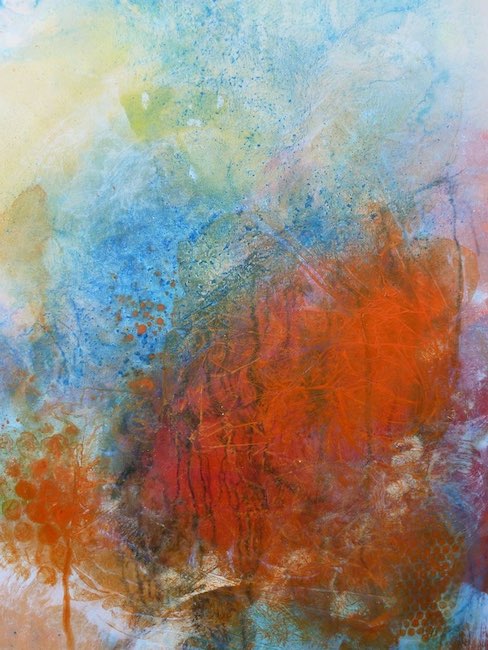
Il dipinto Verwirrungen (Confusioni) è dunque completamente irreale, non racconta di un luogo o di uno scorcio vissuto perché anche laddove vi sia stata una fonte di ispirazione, ciò che poi ha contato è stata la presa di coscienza di una fase di incertezza, di inconsapevolezza sul percorso da intraprendere, sul concetto da estrapolare dagli accadimenti; e dunque la confusione del titolo si svela con tonalità contrastanti come l’arancione e il celeste, che si venano e si espandono all’esterno, contaminano se stesse e il verde tenue intorno, proprio come avviene in quelle fasi disorientanti che a volte avvolgono l’esistenza.

Rose Marie Bolzer espone regolarmente in mostre collettive e personali sia in Austria che all’estero ed è membro dell’Associazione Austriaca di Artisti Professionisti.
ROSE MARIE BOLZER-CONTATTI
Email: rosemarie.bolzer@gmx.at
Sito web: www.rosemarie9.webnode.at
Facebook: www.facebook.com/rosemarie40
Nature as a source of inspiration for more indefinite reflections in the Abstract Expressionism by Rose Marie Bolzer
The contemplation of nature, of the environment that surrounds human beings and that often becomes a precious treasure chest of emotions, memories, evocations of a past experience that remains indelible in the memory, has always exercised an irresistible fascination in many artists, some of whom have based their entire production on its representation. The way in which they have spoken about it has always been in keeping with their expressive nature, their natural inclination towards a certain type of language, in some cases more representative, in others more hermetic, but always the result of the connection between what was observed and what was perceived. The artist I am going to tell you about today starts out from the visible in order to move towards a more or less partial dissolution of the image by virtue of which she goes into the depths of her own feeling.
From the beginning of the 19th century, the predisposition to narrate panoramas devoid of human presence made its way especially to those artists who were more inclined to let their gaze lose itself in the beauty of the natural elements, putting all attention to the subject, understood as an individual, on which the portraiture attention of the previous pictorial movements had focused instead, in the background. English Romanticism, with William Turner and John Constable, emphasised with the one the irresistible force of atmospheric events by virtue of which emerged the meagreness of the human being, and with the other the evocative and soothing power of losing oneself within familiar panoramas linked to pleasant memories, both constituting a point of departure for a different approach to art, more inclined to emphasise all that was put in the background with respect to the protagonism of man, even though the latter’s presence was negligible in the broader context of the world’s existence. A few years later, Impressionism even introduced painting en plein air, in which the painter would come into direct contact with the landscapes and paint them instinctively, without the presence of a preparatory drawing and using quick, short brush strokes with which he reproduced the natural tones and light in front of him; although the Impressionists’ pictorial intent was oriented towards a reproduction that was more aesthetic than emotional, it is undeniable that some of Claude Monet‘s landscapes cannot fail to touch the inner chords that vibrate in the face of the poetic lyricism of his artworks.
As the 20th century approached, a new movement emerged, Expressionism, which took up the legacy of Post-Impressionism, thus a rejection of aesthetics and a celebration of all that was linked to the emotional world to the point of detaching oneself from observed reality to give one’s own personal interpretation of the landscape, as in the enchanting and agitated canvases of Vincent Van Gogh or the intense settings of Ernst Ludwig Kirchner where what predominated over everything was perceived sensation. With the introduction of Abstractionism, where art was no longer to be linked to either emotion or the visible, a rupture was created between the contact with nature of the previous paths and the artist who was to be the executor of a plastic gesture purged of any contact with reality; in fact, however, this type of approach distanced the author from his subjectivity and his own feeling, both of which were in fact recovered with Abstract Expressionism where any sensation could be manifested freely and spontaneously, harmonising with the feeling of the individual executor of the artwork. And it is exactly on this style of painting that the creativity of And it is precisely on this style of painting that the creativity of Austrian artist Rose Marie Bolzer manifests itself, she draws on the emotions and beauty she receives from observing natural contexts and then allows those same sensations to materialise on canvas in an absolutely unregulated manner, without the need for them to be tied to figuration, but can also choose it if her instincts deem it necessary. Not only that, to the creative impulse, where the well-being, the sense of peace, generated in front of the marine, woodland, floral views that constitute her constant source of inspiration cannot help but emerge, Rose Marie Bolzer also adds a strong inclination for experimentation that leads her to mix colours, essentially water-based acrylic paints, with a light layer of material, mainly sand, structural paste, that infuse consistency and greater depth to the final result and on which she then acts with brushes, spatula, sponges and even her hands.
The chromatic range is delicate and shaded in some paintings while more intense and full in others, based on the sensation the artist describes, but in any case what emerges clearly and unequivocally is that lyrical imprint, that poetry that is released whenever the human being in general, and the artist in particular, find that contact with the natural element that is too often forgotten or put in the background compared to the urgency of living. Her Abstract Expressionism is therefore not tormented, it does not show impetuosity, rather it is in tune with the multifacetedness of nature, with the whole range of emotions that change on the basis of the changing mood but also of the landscape with which Bolzer is confronted from time to time; just as the views she observes are filtered and reworked from her depths until they emerge transformed and reworked by her sensitivity, which leads her to move away from the visible to get in touch with the invisible, with everything that cannot be noticed with the eyes but only perceived with the soul. The canvas Herbstwald (Autumn Woods) is intense, it seems as if the artist has placed herself inside the landscape that she then narrates, in an open, interactive way; this is why the tones, although unreal, are akin to autumn, to that particular time of year when nature seems to want to die in order to then subsequently complete the path of rebirth; the yellow ochre of the background therefore represents the colour of the fallen leaves, but also that sensation of evocative silence that envelops the forest at the moment when it seems to fall asleep to enter the arms of winter sleep.
The blue dripping seems to represent the dry trunks, without foliage, whose vitality slips away downwards. Rose Marie Bolzer invites the observer to reflect on how important it is to take example from the cycles of nature every time one is faced with difficulties that have no way out, because sometimes it is necessary to let go, or die, of everything that is no longer functional to one’s path, in order to be able to start living a new existence, one that is more in tune with one’s own chords. In Rote Felsen (Red Rocks), the artist lingers in contemplation of an unusual view, that of rocks that have an unnatural yet evidently possible colour, as infinite as are the options with which nature, and life, manifests itself; in this canvas, the introduction of matter is evident, which somehow remains discreet, never invasive, yet able to emerge, giving greater depth to the image, because in this case Rose Marie Bolzer wishes to emphasise above all the texture of the stone, the artwork’s protagonist, and the contrast with that red hue that distinguishes it.
This painting is decidedly contemplative, the artist’s feeling is of admiration for the beauty before her eyes, and it is only that which she felt the need to immortalise when she placed herself in front of the canvas. But often emotions have to prevail over the observed, over something that is only a stimulus for internalisation, because it is only in the silence of nature that it is possible to enter into a profound dialogue with oneself; and therefore the works that belong to this more intimist side of Bolzer appear more indefinite, blurred, almost impalpable precisely because they belong to the universe of the relative, of that feeling that moves and transforms from moment to moment. The painting Verwirrungen (Confusions) is therefore completely unreal, it does not tell of a place or a glimpse experienced because even where there has been a source of inspiration, what then counted was the awareness of a phase of uncertainty, of unawareness of the path to take, of the concept to extrapolate from the events; and thus the confusion of the title is revealed in contrasting shades such as orange and light blue, which vein and expand outwards, contaminating themselves and the soft green around them, just as happens in those disorienting phases that sometimes envelop existence. Rose Marie Bolzer regularly exhibits in group and solo shows both in Austria and abroad and is a member of the Austrian Association of Professional Artists.


